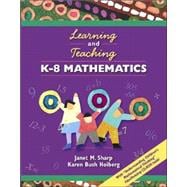
| The basics | |
| Introduction | |
| How We Learn | |
| Theories | |
| Features | |
| Role of the Teacher | |
| Algebra Connections | |
| Middle School Connections | |
| Before we get started | |
| A bit about the NCTM and the NCTM Standards | |
| Technology Connections The Basics | |
| Classroom Connections | |
| Classroom Connections (Video enhanced) Understanding How Children Learn Math | |
| Instruction | |
| Models of Teaching | |
| Problem Solving | |
| Lesson plan components | |
| Classroom Connections Providing Interactive Instruction | |
| Questioning | |
| Assessment | |
| Classroom Connections Using Assessment of Many Forms | |
| Curriculum | |
| Geometry and Spatial Thinking | |
| Thinking about the Mathematics of Geometry and Spatial Thinking | |
| Understanding The Mathematics--Mental Ideas v | |
| Physical Models | |
| Pulling Plane Knowledge from Solid Shapes | |
| Accurate Descriptions | |
| Analyzing a Circle | |
| A Cylinder of a Circle? | |
| Concentrating on the Concepts--Relationships among Shapes | |
| Examples and Non-Examples | |
| Rigid Motions | |
| Symmetry | |
| Classroom Connections Finding Symmetry in Nature | |
| Practicing Spatial Visualizations | |
| Middle School Connections The Net of a Solid Shape | |
| Grasping the Procedures How to Build Shapes | |
| Children Describe a Square | |
| Drawing a Triangle | |
| How We Learn About Geometry and Spatial Thinking | |
| Using Relevant Learning Theory The Van Hiele Theory | |
| (Visual) | |
| (Analysis) | |
| (Informal Deduction) | |
| (Formal Deduction) | |
| (Rigor) | |
| Characteristics of the Theory | |
| Promoting Development | |
| Issues Specific to Spatial Visualization | |
| Using Relevant Patterns Extending Pattern Starters | |
| Repeating v | |
| Growing | |
| Recognizing Deep Structure | |
| Using Teaching Aids Appropriately Concrete, Pictorial, Symbolic | |
| Concrete Representations | |
| Pictorial Representations | |
| Symbolic Representations | |
| Concrete Materials v | |
| Types of Concrete Materials | |
| Cubes | |
| Pattern Blocks | |
| Tangram | |
| Assessment and the Use of Materials | |
| A Chinese Legend | |
| Explore Your Own Culture | |
| Knitting | |
| Literature Connections Developing Mathematical Imagery | |
| Role of the Teacher in Geometry and Spatial Thinking Lessons | |
| Analyzing One of The Teaching Models Discussion | |
| Technology Connections Using Digital Technologies as Geometry Discussion Platforms | |
| Cultural Connections Creating a Mosaic | |
| Highlights of a Lesson Plan Component Creating Good Questions | |
| Suggestions for Establishing Discourse Importance of Knowing the Mathematics | |
| Mrs Hawthorne's Rhombus Lesson | |
| Ms Steffen's Rectangle Lesson | |
| Comparing Quadrilaterals | |
| The Next Question | |
| Middle School Connections Know the Math Well Enough to Ask Questions | |
| Assessment To Make an Instructional Decision | |
| Process of Assessment | |
| Classroom Connections Usi | |
| Table of Contents provided by Publisher. All Rights Reserved. |
The New copy of this book will include any supplemental materials advertised. Please check the title of the book to determine if it should include any access cards, study guides, lab manuals, CDs, etc.
The Used, Rental and eBook copies of this book are not guaranteed to include any supplemental materials. Typically, only the book itself is included. This is true even if the title states it includes any access cards, study guides, lab manuals, CDs, etc.